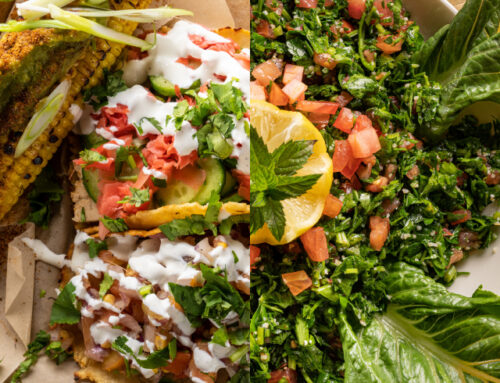Eating in Color
by Cezanne Colvin

The key to good health lies in tasting the rainbow – not the artificial sugary kind, but the one found in nature’s candy.
Most fruits and vegetables are naturally low in calories and fat, and none have cholesterol. They are full of critical vitamins and minerals often stripped from tasty processed foods, as well as packed with dietary fiber. Dietary fiber helps you feel full while lowering your risk of heart disease, stroke, hypertension, diabetes, and obesity, and regulating your bowel functions and blood sugar. Although sugar is sugar, the fiber found in plants is also why sugary fruits don’t spike your blood sugar the way refined sugar does – it’s broken down slowly by the body, so you don’t get a sugar rush.
They also contain phytochemicals, the active compounds found in plants such as antioxidants, flavonoids, phytonutrients, and carotenoids that protect against disease and illness. And when chowing down on plants, don’t forget the skins – colorful peels can be a powerful source of phytochemicals. As an example, potato skin boasts more iron, potassium, and B vitamins than potato flesh ounce for ounce, and they are a strong source of antioxidants.
While many people think of produce as being expensive, buying in-season fruits and vegetables, especially local, can be as or more affordable as processed and refined foods. And if you’re afraid of spoilage, fear not – frozen fruits and vegetables might possess even more nutrients than some fresh produce. This is because frozen fruits and vegetables are picked and quickly frozen when they are at their peak ripeness to retain their color and nutrition, so there’s really no reason to snub
frosty produce.
There are thousands of phytochemicals helpfully lurking inside plants for our consumption, but the only way to get them all is to sample the entire color wheel in the produce section on a regular basis.
Red
Did you know? Red fruits and vegetables are colored from the phytochemicals lycopene and anthocyanin. While both may help keep your heart healthy, lycopene may also reduce the risk of certain types of cancer, especially prostate. Many red fruits and vegetables also contain flavonoids, which may provide anti-viral, anti-inflammatory, and anti-allergy effects.
What to eat: Tomatoes, watermelon, pink grapefruit, red raspberries, strawberries, cranberries, cherries, red cabbage, and red beans.
Up your dosage: Use fresh tomatoes in pasta sauces or add berries to your oatmeal, yogurt, or baked desserts.
Blue & Purple
Did you know? These fruits and vegetables are great sources of anthocyanins and other phytochemicals that can improve memory, vision and weight control. Rainbow carrots do more than make a standard side dish look exotic – their purple color means they not only deliver the usual goods of a carrot, but also the superfood properties that are frequently hailed in blueberries. Just a cup of blueberries – one of nature’s original MVPs – contains 14% of the suggested daily fiber and 24% of the suggested daily Vitamin C intake, and research suggests that it may increase memory, cognitive function, and metabolism, and lower blood pressure, cancer, and heart disease risks.
What to eat: Blueberries, blackberries, elderberries, grapes, plums, and eggplant.
Up your dosage: Luckily, most people find blue and purple fruits and vegetables palatable just as they are. Consider reaching for a cup of berries as a TV snack, or throwing sliced eggplant on the grill alongside your favorite fare.
Orange & Yellow
Did you know? Orange and yellow fruits and vegetables are known for boosting your immune system. Carrots, sweet potatoes, and pumpkins all contain alpha and beta-carotene, which may reduce cancer and heart disease risks. It’s also used by your body to keep your eyes and skin in top working order. Meanwhile, orange and yellow citrus fruits like oranges and tangerines are bursting with bioflavonoids, calcium and vitamin C.
What to eat: Carrots, butternut squash, pumpkins, sweet potatoes, apricots, mangos, oranges, tangerines, lemons, clementines, and pineapple.
Up your dosage: Occasionally swap out a baked white potato for a baked sweet potato, pack an orange instead of chips for a snack, slice carrots to dip in your favorite dips and salsas, and blend squash into your favorite creamy sauces for a nutritional punch.
Green
Did you know? We know, we know – few things are reinforced as much as the importance of eating your greens. Cruciferous vegetables such as broccoli contain indoles, which may protect against some types of cancer, while other leafy greens are bursting with lutein, which may help fight vision loss and cataracts, making lutein and green vegetables critical to our daily diets. Although romaine lettuce is a mild-tasting salad staple, consider occasionally swapping it out for kale – 1 cup of romaine has 1 gram of protein, 5% of the daily recommended intake of vitamin C, and 2% of the daily recommended intake of calcium, but 1 cup of kale has 2.9 grams of protein, 134% of vitamin C, and 10% of calcium.
What to eat: Spinach, kale, broccoli, collards, snap peas, arugula, Brussels sprouts, green beans, and bok choy.
Up your dosage: Although many greens can be weaved into salads and substituted in favorite recipes, too much chewing can start to make us feel like we’re stuck in a food pyramid pasture. For a quick way to get your leafy greens, just blend a cup or two into your favorite smoothie.
White
Did you know? Unlike white processed foods, white foods found in nature haven’t been stripped of their nutrition. White fruits and vegetables are known for their anti-inflammatory properties and contain antioxidants called anthoxanthins, which may lower cancer and heart disease risks. Additionally, foods like garlic and onions do more than add flavor to your sauces and stocks – they contain allicin, which may lower cholesterol and blood pressure levels, as well as the risk of heart disease and cancer.
Up your dosage: Parsnips, garlic, onions, apples, bananas, coconut, cauliflower, and jicama.
Fit it in: Blend a couple of frozen bananas in a blender or high-speed processor for an all-natural ice cream, or try substituting cauliflower for fried rice, buffalo wings, mashed potatoes, or pizza crust. (Note: Have you ever roasted garlic in the oven and spread it on a baguette? After you try it, you’ll be asking everyone you know the same question.)
As seen in the Summer/Fall 2015 Issue
Click to Visit Our Advertisers




